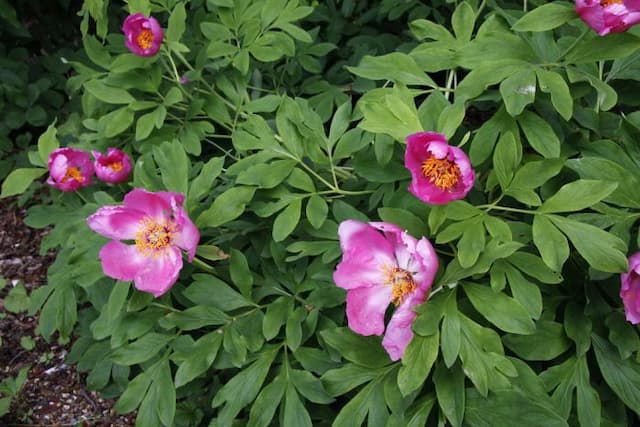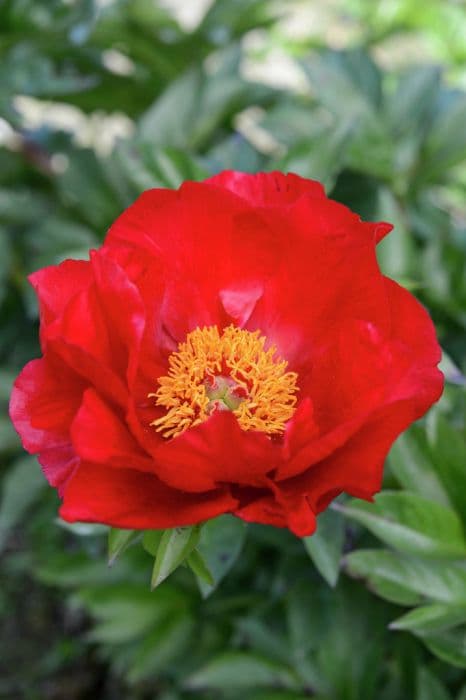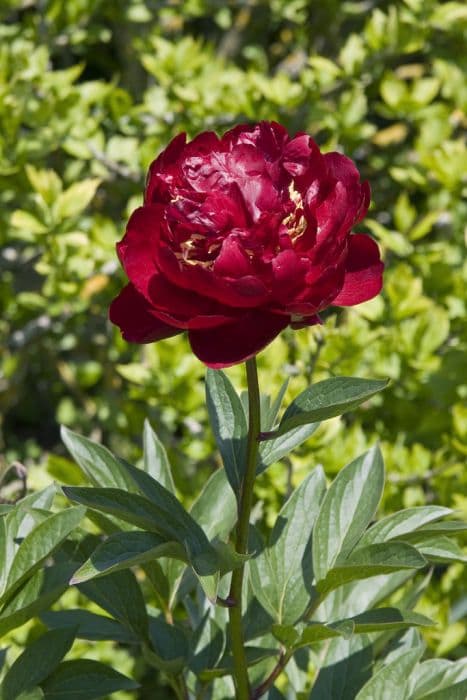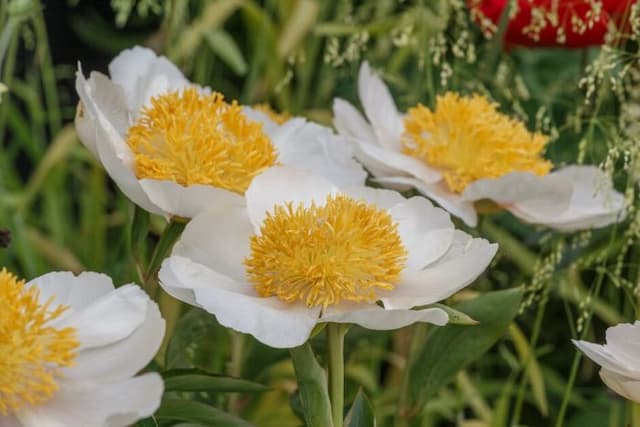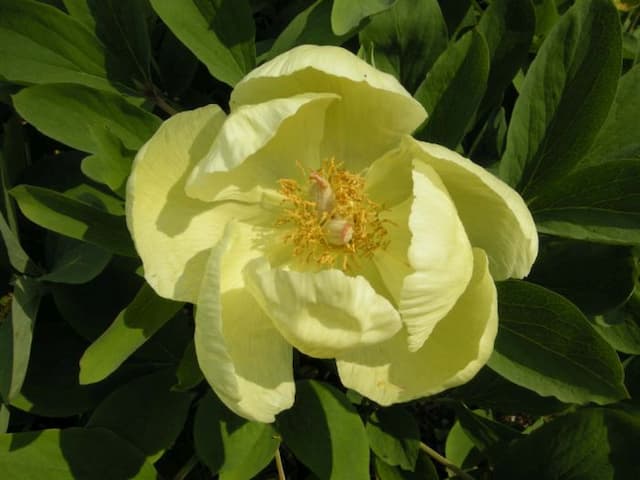High Noon Peony Paeonia × lemoinei 'High Noon' (S)

ABOUT
'High Noon' is a cultivar of tree peony, showcasing lush, deeply lobed, green foliage that provides an excellent backdrop for its blooms. The flowers are truly the stars of this plant, being large, showy, and cup-shaped with a sunny yellow hue that can brighten up any garden space. Each flower features a core of golden-yellow stamens that stand out against the soft petals, adding a touch of elegance and contrast. The plant typically blooms in the late spring to early summer, releasing a delightful lemony fragrance that can be enjoyed by anyone passing by. As a tree peony, the plant has a woody structure and does not die back to the ground like some other peony types, instead maintaining a presence year-round. The flowers are often said to evoke a sense of romance and whimsy, making them a favorite for garden enthusiasts and floral arrangers alike.
About this plant
 Names
NamesFamily
Paeoniaceae
Synonyms
High Noon Peony, Lemoine's Peony, Tree Peony 'High Noon'
Common names
Paeonia × lemoinei 'High Noon'
 Toxicity
ToxicityTo humans
The plant commonly known as 'High Noon' Tree Peony (Paeonia × lemoinei 'High Noon') is not considered highly toxic to humans. However, ingesting parts of peonies can cause gastrointestinal upset, such as nausea, vomiting, and diarrhea. Contact with its sap may also cause skin irritation in sensitive individuals. While serious complications are rare, it is advisable to avoid consuming this plant.
To pets
The 'High Noon' Tree Peony (Paeonia × lemoinei 'High Noon') is generally considered non-toxic to pets, including dogs and cats. Nevertheless, as with humans, ingestion of parts of the plant might result in mild gastrointestinal upset such as vomiting or diarrhea in some pets. Consumption of large quantities is discouraged, as it might lead to more severe symptoms, though this is relatively unusual. It's best to keep an eye on your pet and consult a veterinarian if any adverse reactions are observed.
 Characteristics
CharacteristicsLife cycle
Perennials
Foliage type
Deciduous
Color of leaves
Green
Flower color
Yellow
Height
4 feet (1.22 meters)
Spread
3 feet (0.91 meters)
Plant type
Shrub
Hardiness zones
4
Native area
China
Benefits
 General Benefits
General Benefits- Attractive Flowers: Paeonia 'High Noon', commonly known as Lemoine's Peony, produces large, yellow blooms that add color and visual interest to gardens.
- Fragrance: The flowers emit a pleasant, sweet scent that can enhance the sensory experience of a garden.
- Landscape Focal Point: The striking blooms and foliage of Lemoine's Peony make it a standout feature in landscape designs.
- Longevity: Peonies are known for being long-lived perennials, often living for decades with proper care.
- Seasonal Interest: Blooms in late spring or early summer, providing a burst of color after many spring bulbs have finished flowering.
- Drought Tolerance: Once established, it has a degree of drought tolerance, making it suitable for gardens with less frequent watering.
- Diverse Uses: Can be used in borders, as specimen plants, or in mass plantings for greater visual impact.
- Cold Hardiness: Peonies are cold hardy, making them suitable for growing in climate zones with harsh winters.
- Cut Flowers: The blooms are excellent for cutting and can create beautiful indoor floral arrangements.
- Pollinator Friendly: Attracts bees and other pollinators, thus supporting biodiversity in the garden.
- Maintenance: Low-maintenance requirements once established, needing only occasional care.
 Medical Properties
Medical PropertiesThis plant is not used for medical purposes.
 Air-purifying Qualities
Air-purifying QualitiesThis plant is not specifically known for air purifying qualities.
 Other Uses
Other Uses- Paeonia 'High Noon', commonly known as tree peony, can be used in the creation of natural dyes due to the pigments present in its petals which can vary from yellow to deep red.
- The fallen petals of the tree peony can be added to compost piles as a source of organic matter that will break down to enrich the soil.
- Tree peony branches can be used in floral arrangements and Ikebana, the Japanese art of flower arrangement, thanks to their sturdy structure and attractive blooms.
- The large and colorful blossoms of tree peonies can serve as an organic confetti for outdoor celebrations, providing an environmentally friendly alternative to synthetic materials.
- Used in perfumery, the petals of tree peonies can contribute to the creation of floral scents, although they are not a primary source for perfume extract.
- Tree peony roots and bark, usually from other species and not specifically 'High Noon', have been utilized historically in woodworking and crafting decorative items.
- The seed oil from tree peonies can be extracted and utilized in the formulation of cosmetics, such as lotions and creams, for its moisturizing properties.
- Tree peony flowers can be pressed and included in artisanal paper making to create decorative paper with floral inclusions.
- The patterns and colors of tree peony petals can inspire artists and designers in creating textiles, wallpapers, and other design elements.
- As an educational tool, tree peonies can be used to teach botany and plant reproduction, showcasing their distinct peony seed pods and flowering process.
Interesting Facts
 Feng Shui
Feng ShuiThe Peony is often used in Feng Shui for its associations with prosperity, good luck, love, and feminine beauty. In Feng Shui practice, it is recommended to place peonies in the southwest area of a home or garden to enhance love and romance. For those seeking marriage or relationship luck, it is especially beneficial to display peonies in the bedroom. However, avoid placing too many peonies, as they can overwhelm the energy of the space.
 Zodiac Sign Compitability
Zodiac Sign CompitabilityThe Peony is not used in astrology practice.
 Plant Symbolism
Plant Symbolism- Prosperity: In many cultures, the peony is associated with wealth and honor, and 'High Noon' is no exception, symbolizing hope for abundance and financial success.
- Romance: With its full, lush blooms, the peony is often considered a symbol of romance and marital bliss, suggesting the 'High Noon' variety could represent the peak of romantic endeavors.
- Beauty: Peonies are widely regarded for their beauty, with 'High Noon' peonies showcasing an exceptional aesthetic that can symbolize the idea of breathtaking beauty.
- Good Fortune: The peony, 'High Noon' included, is considered a good omen, often signaling good fortune and a positive turn in the journey of life.
- Compassion: The soft and delicate nature of peony petals can represent compassion, suggesting the presence of empathy and understanding in relationships.
 Water
WaterThe Tree Peony 'High Noon' should be watered deeply once a week during the growing season, provided there has not been substantial rainfall. Use a soaker hose or drip irrigation to apply approximately 1 to 1.5 gallons of water directly to the base of the plant, avoiding overhead watering which can lead to fungal diseases. During the dormant period, in the fall and winter, reduce watering to when the soil is dry to the touch, as the plant's water requirements diminish.
 Light
LightThe Tree Peony 'High Noon' thrives best in full sun to partial shade. It should be planted in a location where it receives at least six hours of sunlight daily. The ideal spot would protect the plant from intense afternoon sun in hotter climates.
 Temperature
TemperatureThe Tree Peony 'High Noon' is hardy and can tolerate winter temperatures as low as -20 degrees Fahrenheit, but the ideal growing temperature range is between 65 and 75 degrees Fahrenheit during the day. It can withstand short periods of higher temperatures; however, prolonged heat can stress the plant.
 Pruning
PruningPrune Tree Peony 'High Noon' after it has finished flowering, usually in late spring or early summer, to remove spent blooms and shape the plant. Cut back the spent flower stems to a strong leaf bud. Pruning helps encourage healthy growth and next season's blooms.
 Cleaning
CleaningAs needed
 Soil
SoilThe Tree Peony 'High Noon' thrives in well-draining soil with a pH of 6.5 to 7.0. A best soil mix would be equal parts garden soil, compost, and perlite or coarse sand to enhance drainage. Mulching helps maintain moisture and soil temperature.
 Repotting
RepottingTree Peonies like 'High Noon' rarely need to be repotted since they are typically grown in the ground. If grown in containers, repot every 3 to 5 years or when the plant outgrows its pot.
 Humidity & Misting
Humidity & MistingTree Peonies such as 'High Noon' are tolerant of a range of humidity levels and do not require high humidity environments. They perform well in average garden conditions.
 Suitable locations
Suitable locationsIndoor
Ensure bright light, cool temperatures, and well-draining soil.
Outdoor
Plant in well-drained soil, full sun to partial shade.
Hardiness zone
4-8 USDA
 Life cycle
Life cyclePeony 'High Noon' seeds germinate in the spring, requiring stratification to break dormancy. After germination, the young plant develops a root system and foliage, going through a vegetative stage. The peony plant enters a period of growth and maturation where it establishes itself firmly. Once mature, typically after several years, 'High Noon' produces its distinctive yellow blossoms in late spring to early summer. After flowering, the plant develops seed pods if pollination has occurred. In autumn, the plant enters dormancy, with foliage dying back to the ground, while the roots survive underground to regrow the following spring.
 Propogation
PropogationPropogation time
Spring
The most popular method of propagation for the Paeonia × lemoinei 'High Noon', commonly known as a type of tree peony, is by division. Division is typically done in the fall, after the plants have gone dormant. Care is taken to dig up the plant with as much root system intact as possible. The root clump is then gently separated into smaller sections, making sure that each new section has at least 3-5 eyes, which are potential growth points for new shoots. The divisions are replanted in well-draining soil at the same depth they were previously growing. It is important to water the newly planted divisions thoroughly to help establish them. The divisions may take a couple of years to flower as they establish themselves.
